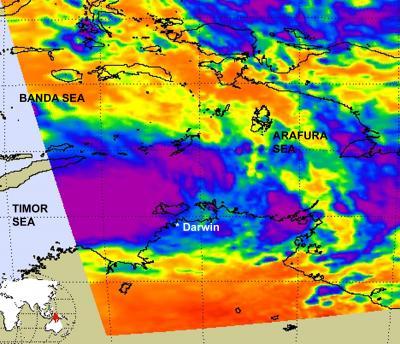NASA's Aqua satellite captured a low pressure area known as System 99S that appears to be strengthening very close to Darwin, Australia. Aqua satellite data indicated that the strongest thunderstorms were over the Timor Sea on Feb. 15.
System 99S is a threat to Australia's Northern Territory because on Feb. 15 it was centered only 20 miles (32 km) south of Darwin, Australia, near 12.7 degrees South latitude and 130.7 degrees East longitude. The Joint Typhoon Warning Center gives System 99S a good chance for development in the next 24 hours, and NASA satellite imagery confirms the strong convection and thunderstorms developing in the system.
The Atmospheric Infrared Sounder (AIRS) instrument aboard NASA's Aqua satellite captured an infrared image of System 99S on Feb. 15 at 0441 UTC. The infrared image was created at NASA's Jet Propulsion Laboratory in Pasadena, Calif. and showed very strong convection over the Timor Sea (part of the Southern Indian Ocean basin), with the southernmost edge of precipitation near Darwin. That strong convection was represented in thunderstorm cloud-top temperatures as cold as or colder than -63 Fahrenheit (-52 Celsius). Cyclones or hurricanes are made up of hundreds of thunderstorms that circle a low pressure center.

The AIRS instrument aboard NASA's Aqua satellite captured an infrared image of System 99S on Feb. 15 at 0441 UTC. The strongest convection (purple) was over the Timor Sea and represented in thunderstorm cloud-top temperatures as cold as or colder than -63 Fahrenheit (-52 Celsius).
(Photo Credit: NASA JPL, Ed Olsen)
Warnings are now in effect for the Northern Territories, Australia. A Cyclone Warning is in effect for coastal areas from Daly River Mouth to Point Stuart, including Darwin and the Tiwi Islands. In addition, a Cyclone Watch is in effect for coastal areas from Port Keats to Daly River Mouth and Point Stuart to Goulburn Island.
Winds in the area of Darwin are estimated near 25 to 30 knots 29 to 34 mph/36 to 55 kmh). System 99S is meandering northwestward at 1 knot (1 mph/2 kmh). Doppler weather radar at Darwin shows intense convection (thunderstorms) banding along the northern semicircle of the low level circulation center.
Forecasters expect System 99S to strengthen as its center drifts over the warm ocean surface. Currently, there is a good chance that System 99S will become a tropical depression or tropical storm.
Source: NASA/Goddard Space Flight Center